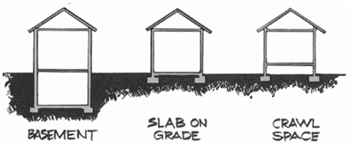Since the very first development in masonry and house building in the Neolithic period, foundations have been an essential part of architecture and construction. A strong foundation determines the durability of the architecture against the forces of nature and provides a safe place for the people to live in. The type of foundation differs from place to place and depends on the type of land and the type of building. With the various advancements in masonry and architecture, there are several types of house foundation. Let us discuss the advantages and disadvantages of the different types of foundations used in house building.

Image Credits @ http://www.radonfree.com/techniques
1. Crawlspace Foundation
As the name suggests, the crawlspace foundation features a small basement like foundation which is laid in concrete that supports the entire structure of a house. It is often built on a soil land where digging is not a tough task as compared to a hill side location. The ground is dug as deep as 3-4 feet and a concrete perimeter and concrete pillars are placed strategically to support the structure. Below are the pros and cons of utilizing the crawlspace foundation for your house.
Pros
The best advantage of a crawlspace foundation lies in its durability in areas with high ground water level. The crawlspace protects the house from loose soil during heavy rains. The crawlspace allows for better airspace under the house that would help the house remain cool in summers. Flood vents can be added to the crawlspace foundations to for protection of the building during floods. Crawlspaces can also be used for storing items.
Cons
The air space under the house can make the house really chilly in winters. Additionally as crawlspaces are hardly used other than storage, they can get infested with vermin and mold. Improper ventilation and insulation of crawlspaces could also result in faecal matter from dust mites and decomposition odour from the stagnant water. These can often cause serious health threats for the people living in the house.
2. Basement Foundation
A basement foundation is simply a more extensive version of the crawlspace foundation which is used for living as well as storage purposes. The basement foundation features a similar perimeter and concrete pillars to support the building’s structure with the difference being in the depth of the foundation. A basement foundation is usually dug at a minimum depth of 8 feet above the footing. The pros and cons of the basement foundation are.
Pros
Basements provide a natural air space underneath the house that helps in effective cooling of the house in summers. As the space is often used for dwelling and is maintained properly by the homeowners it is less likely to get infested. Basement also allows for better site utilization by giving an extra place to live or store goods without the expansion of property. Basement also allows for easy access in case of any repair work like leaking pipes etc.
Cons
Despite its advantages, the basement foundations can be a pricey affair and can cost a lot more than the conventional foundations. Basements if not maintained properly can be even larger dwelling places of moulds and vermin. In case of flooding and improper drainage, basements can often cause damage to the house’s foundations.
3. Slab Foundation
The most commonly utilized foundation in house building; slab foundation refers to a slab formed by a block of concrete upon which a house is built. The slab is roughly 4-8 inches thick and is embedded with steel rods and the water and drainage pipelines are laid prior to pouring the concrete. It is one of the most popular types of foundations due to its quick laying process and low costs. Below are the pros and cons of Slab Foundation.
Pros
The popularity of slab foundations lies in its low cost. The crawlspace and basement foundations cost much higher as compared to the slab foundation. Due to the lack of airspace, there is no room for termite or mold infestation that is a common problem with crawlspace and basement foundations. This works best for places with a warmer climate where snowing and thawing is not an issue.
Cons
Repairing the leaking and damaged lines can become a cumbersome situation in slab foundation as the lines are embedded in the concrete slabs. The slab foundation houses are also susceptible to warming up due to lack of ventilation space underneath. The low elevation offers poor protection from floods, and remodelling can also be a hard to handle situation. If this is the case, check out foundation repair in Houston for immediate advice.
While there are several other modern foundation types, the above mentioned are the most commonly utilized. The type of foundation differs from place to place and depends largely on one’s budget, construction norms and the owner’s utility.

Leave a Reply
You must be logged in to post a comment.